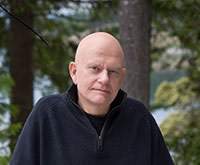
In the far future, the Human Empire has been attacked by the alien Hudatha. Humanity's last hope lies with the Legion, an elite fighting force of cyborg soldiers. When there's no more hope for the terminally ill or for condemned criminals, there is one last chance to survive. Become both more and less than human - become a cyborg - and join the Legion of the Damned.
Throughout his writing, Dietz intention has been to create a sprawling universe that could not only provide the setting for numerous stories, but allow those to stories to share characters or reference each other within the sprawling world he has created, one that explores several interesting science fiction themes like futuristic soldiers, alien politics, cyborgs, and shape shifters.
Having now written more than 40 novels, including tie-in novels for Halo, Mass Effect, Resistance, Starcraft, Star Wars, and Hitman, Dietz is more than qualified to talk about world building, and we’re lucky enough to have him write a guest blog for us on that very subject.
So dig in, and if you want more, the latest in the series, ‘The Final Battle’ (Legion of the Damned 2), is out on the 8th August.
Enjoy!
William C. Dietz, July 27, 2014 - World Building
When it comes to building a world (or worlds) the concept usually comes first. That's how it works for me anyway. The Legion of the Damned novels are a good example. Prior to writing the first book I wanted to write a military science fiction series that would be different from all the rest. And I knew it wouldn't be easy because so many great ideas had already been taken. Soldiers in space? Done. Read Starship Troopers by Robert Heinlein. Straight up space mercenaries? Done. Read the Falkenberg's Legion books by Jerry Pournell. Mercenaries with tanks? Done. Read the Hammer's Slammers series by Dave Drake.

But there was one more element that I wanted to add and that was the concept of military cyborgs. The Free Dictionary defines a cyborg as, "A person whose physiological functioning is enhanced by mechanical or electronic devices," and guess what? Many of us qualify. I have manufactured lenses in both eyes, wounded soldiers are being equipped with bio-mechanical limbs, and all of these developments point to a time in the future when it will be possible to transplant a human brain into an electro-mechanical body.
When that day arrives it will seem innocent enough and offer the terminally ill with a chance to live out their lives. But given how eager humans are to kill each other it won't be long before we weaponize such high tech bodies and immediately put them to work. And that's another thing that makes the Legion of the Damned somewhat unique. Some of its members are housed in highly specialized fighting machines. For more on that I hope you'll read the books!
As I said earlier, when building a world (or worlds) the concept comes first. Well, once I came up with my fictional army there was a need. And not just worlds but alien worlds, alien politics, alien-human politics, space ships, hyperdrives, and all the rest of it. And I was determined to go BIG from the beginning which meant there was a lot of prep work to do.
The good news was that I had lots of ideas, including major characters (human and alien), but before I could flesh them out I needed to reverse engineer planets for them to live on. That is to say I knew what I wanted my alien races to look like, and the perspectives they would have, but I needed to create the planets that would logically give rise to such beings. And to do that I needed help. I'm not a physicist, so how was I going to figure out what sort of sun a particular planet would have? How a moon or moons might influence its orbit? What surface conditions would be like? And so on. It was like hitting a brick wall.
Oh, and this was just prior to the point when the Internet really came into its own, so resources were limited. Yes, one could go to the library, but guess what? There weren't any books that told you how to build a planet. (Interestingly enough there are websites for that purpose now.)
Fortunately I got lucky. I was reading the want ads in the back of an SF publication when one of them caught my eye. A professor of physics at a college back east was willing to build worlds for writers who needed them. For the fun of it!
I could hardly believe my good fortune and sent him a letter. Yes, a real honest to god letter, since the only people who had email were a few academics. And, long story short, a wonderful collaboration was born. Dr. Sheridan Simon was a joy to work with and brilliant man. After reading my descriptions of various races he was able to reverse engineer the planets they lived on. One such race is the Naa. Here's an excerpt from Andromeda's War which will be released in December.
"Gordon, McKee, and Jivani picked their way down past the defensive positions to the bottom of the slope. The Naa were milling around. A warrior slid down off his dooth. He had variegated white and gray fur. The ears that stuck up from his skull gave him a vaguely feline appearance.
McKee knew that the Naa had four fingers and opposable thumbs just like Humans did. But their feet were wider and lacked toes. This male was about six and a half feet tall and dressed in a vest and trousers. A fully loaded cartridge belt circled his waist and he had a Legion issue sniper's rifle slung across his back. As what? An insult? Or simply the best weapon for a sharp shooter to own? Not that both couldn't be true at the same time."
So that's what the Naa look like. Here's an excerpt from the very first book, Legion of the Damned, which describes their home planet as designed by Sheridan and put into words by me.
"It was a beautiful day. The sun was out, the air was crystal clear, and the mountains seemed so close that St. James could reach out and touch them. The Towers of Algeron. That's what the Naa called them and they deserved a majestic name. Some of the higher peaks soared 80,000 feet into the sky, higher than Everest on Earth, or Olympic Mons on Mars. So huge, and so heavy, that they would sink right through Terra's planetary crust.
But Algeron was different from Earth. Very different. And almost all of the differences stemmed from the fact that Algeron completed a full rotation every 2-hours and 42-minutes. A rotation so fast that centrifugal force had caused a larger than normal bulge at the equator.
In fact, while Algeron's mass was virtually identical to Earth's, its equatorial diameter of 16,220 km was 27% larger than Earth's. That, plus the fact that its polar diameter of only 8,720 km was 32% smaller than Earth's, meant that Algeron's equatorial diameter was almost twice that of its polar diameter.
And that's where the Towers of Algeron came in. They were the top most part of the world spanning bulge, and thanks to the gravity differential that existed between the poles and the equator, weighed only half what they would on Terra.
All of which had nothing to do with Camerone Day, or the legionnaires waiting for St. James to speak, except that it pleased him to think about it. And that was one of the privileges that went with rank: long silences, and the assumption that they were in some way profound."
So there you have it... A planet born of a backwards process that gave me exactly what I needed, even if I wasn't expecting a world where each day lasted only 2-hours and 42-minutes! A reality that I would have to deal with every time I wrote something that took place on Algeron. And that happened frequently. Imagine fighting battles on a world where the sun constantly sets and rises! Something like that changes everything.
Sadly Sheridan died of cancer before we could meet face-to-face, but I'd like to think that he'd be proud of the imaginary planets he helped to create, and the books set on them. Viva la legion!